Monday, March 31, 2008
Monday March 31, 2008
I don’t know what my feelings are. A man should have some kind of feelings when his mother dies. She isn’t dead today. She’s dying. She’s in a hospital in Roseville, a small town near Sacramento, California. I haven’t been in California since December 1988 when I left the place I was born to move to Chicago and make a new start. I’ve been in Chicago ever since, not even going back for a visit. I’ve talked to my oldest brother Don on the phone a few times and a short “hello” to Mom was part of those conversations, but I can’t really say that I’ve talked to my mother since the mid-1980’s; 20 years have passed.
Mom has had Parkinson’s disease for a while now and has been mostly incoherent and senile for quite a few years. That’s no excuse for a guy not to talk with his Mom and no excuse to stop loving the woman who brought me into the world, fed me, cared for me, taught me to read and sing, taught me about humor and silliness, showed me how a positive attitude can make a big difference in life.
She also taught me to be ashamed of my body and to feel dirty about sexuality. She taught me that God was always watching me and that nothing about myself truly belongs to me. She taught me that pride is a sin—that ALL pride is sinful and that I couldn’t ever feel good about myself without being bad in the eyes of God.
She was my best friend when I was little, but she was also the worst enemy of my self-esteem.
Now she’s dying and I don’t know how to feel.
I want to go to her, but I don’t have the money to travel to California and back. I would call on the phone, but I don’t know if the people at the hospital would even let me talk to her. And if I did get to talk to her, what good would it do? Would she know who I was? Does she know who I am? The deterioration of her mind is in a really advanced state by now. A phone call would do nothing except shake the reluctant tears out of me. I would be calling just to help myself grieve.
My brother Gerald—who I also haven’t talked with in 20 years—sounded so different from the brother I remember. He sounded like an old guy. He’d be…56 or so right now. Don is 10 years older than I am and Gerald is two years younger than Don. This is so sad that I don’t even know the ages of the members of my own family. They haven’t seemed like family to me in a long time. When I moved to Chicago, I guess I kind of declared myself to be an orphan or a man without a past or a family. I wanted a complete break from all I had known in California. As a teenager I was so surrounded by crime and drugs and death that I was sure that I could never survive unless I got OUT—unless I could be far away from that place. And I left without looking back.
They wouldn’t have known where I am at all if not for the requirements of the Ba’hai religion regarding marriages. And I’m not even Ba’hai, nor is my wife Kim.
But Kim was raised Catholic and she had already been married once in the Catholic Church. Her marriage to me wouldn’t be recognized in the Catholic Church because she got divorced for a reason other than adultery and that isn’t a proper catholic divorce, therefore her marriage to me couldn’t be a proper catholic marriage.
In short, we shopped for a place to get married and the Ba’hai Temple in nearby Wilmette was the nicest temple we saw. The price was good too. Free. They only had a couple of stipulations, one of them being that no members of the couple’s respective families could have any objection to the marriage.
Romeo and Juliet couldn’t have had a Ba’hai wedding. Bob and Kim could, but only if Bob got either A) his family to attend the ceremony or B) a written statement saying that they approve of the marriage.
So I contacted them to tell them I was getting married to a non-white woman in a non-christian ceremony. I composed a letter for them to sign and return to me. They went along with it, even though I’m sure they were mystified by my request for family approval.
Up until then, my oldest brother and my mother had no idea where I was and my middle brother Gerald—the one who called me today—was in prison and probably had things other-than-me to think about.
But that’s how they came to know where I was and what I was doing and how to get ahold of me. I’ve had the same phone number all this time.
Then today, Gerald called me to tell me Mom is dying. And all I can think to do is write in my journal.
I loved you. Mom. I found that I couldn’t accept the religion you wanted me to accept and not accepting your religion made me feel like I couldn’t be the son you wanted me to be. The place you tried to raise me was a place—or maybe a time—that was full of horrors for me and I had to leave that place. I left you because I had to run away from the place you lived. But I loved you. I just couldn’t make the same choices for myself that I felt you were making for me. I needed to have a better chance to survive. I needed a better education and better employment opportunities. I needed some better ideas about God, too. I needed to fill myself with the good qualities that I couldn’t find in our hometown. I had to get away. But I loved you.
I will call.
I will say, “Mom, this is your son Robert. I love you, Mom. I grew up and I’m doing good. I love you. Goodbye, Mom.”
Sunday, March 30, 2008
"Other" Still Number One
The article missed a couple of important points, namely that "Roman" is no longer a nationality even though the remnants of the Roman Empire survive only as the aforementioned religion and that the percentages cited in the article indicate that the actual number one "religion" is still "other".
I'm an ordinary, every day, garden-variety pagan, like most people.
Friday, March 28, 2008
Creation Versus Evolution?
The other day I was cyber-surfing a little bit, just trying to keep up with current events, and I clicked a link in the news window of my homepage to look at an article on LiveScience.com that had a title that was something like "Top Ten Missing Links". LiveScience is an entertaining site, full of all sorts of the type of pop-science that most internet users love to look at. I'm sure there must be some real science in there somewhere, but it's mostly "science-y stuff for the masses".
"Missing links" indeed.
I had already registered with LiveScience so I could comment on articles and so I could use their RSS feed on one of my other blog pages. My prior registration seems to have turned into a "missing link".
The article I'm referring to is a photo gallery of the "top ten" (their picks, not mine) pre-sapien hominids whose bones have been unearthed and looked at by archaeologists, including the famous "Lucy", an austalopithicene chick, a few Neanderthal and Cro Magnon dudes, etc.
I suppose the upshot is that LiveScience wants to show some "proof" of humanity's less-than-human origins.
Meanwhile the idea of "we evolved from monkeys" is still quite offensive to religious people, no matter how many "scientists" say things like "we didn't say we evolved from monkeys".
"Yes you did."
"No we didn't."
And so on.
Sure enough, the first comment on the article was from an intelligent-sounding guy who said (I'm paraphrasing from memory) "...still no compelling proof of evolution..."
Well none of us is ever truly compelled to believe what we don't want to believe, especially when the subject in question involves remote history (let's face it: we weren't there) or any other thing where direct observation is impossible. There IS NO objective, quantifiable observation of things like morality, the meaning of life, the existence of an afterlife, the edge of the universe or the beginning of time. It's all guesswork and we all believe what we want to believe. There are (and I believe that there always will be) exactly ZERO provable facts in these cases.
The funny thought that occurs to my tiny, possibly monkey-derived brain is that maybe we don't need to have big, bloody battles about things we can never prove. Maybe there's a lot of it--important though it may seem--where we should just realize that what we think we know is really nothing more than our personal beliefs.
I wrote another article about it. It's long and it's unfinished. I'm going to post it here today so I'll stop writing it, making it ever longer, making it ask more questions and leave more questions unanswered. It seems to me that the human mind has difficulty tolerating questions that can't be answered, so we keep pushing our minds to find the answers even when we know that we can't come up with a true and factual answer. We still want to think of what is possible, then choose the possibility that appeals to us the most.
Anyway, here's my article:
Evolution Versus Creation?
There are a few areas of discussion where I feel that I could make a valuable contribution, where the things that need to be said haven’t really been said. This is one.
My primary reason for thinking that I have a contribution to make is because of the polarization that exists regarding this debate. There are several such debates in our society of the sort where no resolution seems to be forthcoming. This polarization, partisanism, “taking of sides” or whatever you would like to call it keeps us from attaining the social agreements that we would need in order to be a cohesive society.
I’ve written about this before, but I haven’t written so well as to feel that I have said all that needs to be said or even all that I would want to say. So I’m trying again. I expect disagreements from both sides simply because there are two very separate sides and I’m not on either of them.
Or I’m on both of them. Confusing? Not really. I’m on neither side and on both sides. I’m a moderate because more than any other thing, I desire social healing. I want to live in A Society rather than living as I do now on the fringes of fragmented societies. I don’t want to spend the rest of my life straddling some crazy fence with one foot in one world and the other foot at the opposite end of the universe.
I’m an American. I don’t want to think of myself as belonging to some ethnically or religiously divided version of my society. I don’t want to feel any compulsion to think of myself (or worse—to have others identify me as) Euro-American, or theist/atheist, liberal/conservative, black/white. I’d like to think of myself as merely American: capable of agreeing on the important matters with any other American. The quest for agreement with my society seems to entail a few moments of seeming to disagree with everyone. In a world where all the people have divided themselves into A’s and B’s, I’m the sort of person who just wants to do the math that adds A and B and comes up with C because C is the group in which I belong. C is the set of nice people, some of whom are A’s and some of whom are B’s.
Maybe an X,Y, Z equation would be more PC. IDK. LOL.
So…I would like to ask both “evolutionists” and “creationists” to prepare to approach the fence that divides our society and for everyone to be ready to do some genuine healing of our shared world by removing the blinders of your own limited opinion. Don’t do it for me. Do it for the higher purpose, the greater good, unity, love, the collective consciousness, the world-soul or for God—whichever of those ideas (if any) seem worthy to you.
The sciences are in the domain of thought, while spirituality is in the domain of feeling. Humans are the beings who do both: we think and we feel. If thinking and feeling were always completely reconciled, we would probably never have the need to communicate. Arguments span the entire spectrum from communication with a view to reaching agreement all the way to out-and-out warfare. My recommendation is a simple one. Let’s communicate and disagree when we must, but until we declare communication to be at an end, we don’t need to beat each other up.
As a sworn moderate, I will trace the argument back to the last place we were before we decided we couldn’t communicate. I will attempt to begin with a tentative agreement: at some point in time, non-aware matter became something that is alive and knows it is alive, but also knows that it is in some ways separate from- and in other ways connected to-the rest of the universe. We’re individuals AND we’re connected, but the important realization is that we’re alive and aware. We’re aware of ourselves as living beings and we’re more-or-less aware that other living beings exist who are potentially connected with ourselves somehow.
The “somehow” seems to us to be largely a matter of our choice. We choose to connect ourselves with the parts of the outside world (including the people in that outside world) that we want to connect with and we try to choose to distance ourselves from the parts of the outside world with which we do not wish to be associated. In our hubris, we think that we can somehow exclude parts of the outside world from our concept of ourselves by shutting the undesirable bits (these “bits” are people not really so different from ourselves) out of our awareness. What we don’t like, we reject in the same way that a body rejects a transplanted organ. It matters not at all to us that acceptance might save our lives.
Somewhere between six thousand and four million years ago (depending on how you count and who keeps your calendar) a new sort of life appeared on Earth: humans. We’ve been arguing ever since. We’ve argued about which of us are “real humans”, about what “right thinking” is, about what should be important to us, about which real estate belongs to which group of humans, about who is included in which group and even about how to measure time. The basis of all of this arguing comes down to one simple point: we have questions about which of our fellow creatures we like and how much we should like them. We almost universally decide that we will like the ones with whom we have the most in common. We decide to like people who are like us in some significant way and we often decide to dislike those who are unlike us.
You could disagree with me at this point, but that wouldn’t do you much good. Your disagreement would merely be a case of you saying that you don’t like what I have to say because I’ve said something that is different from what you think; you’d be pointing out that your opinion on the subject of like and unlike is unlike my opinion and that you don’t like that.
Yes, I am using the term “like” in a funny way. I’m doing strange word-magic with it, but it’s justified word-magic because—at least in English—we have a word that points to the obvious fact that we feel an emotional connection to people who are similar to us; that we like those who are like us.
And we dislike those who are unlike us. Unless of course we don’t like ourselves, in which case we dislike others for being too much like us. Complicated? Yes. For something so simple, it IS very complicated.
Here’s how to solve any problem that is both simple AND complicated: keep the simple part in your mind as you work your way through the complicated part. Not many people solve problems that way, but that’s the way to do it. It’s just like division or multiplication without a calculator: figure the simplest part first, make a note of it, then calculate the next-simplest part and so on, making notes of the simplified parts as you go. Be the first one on your block to know the real method for solving problems!!! Start today!!! No extra charge!!! No hidden fees!!!
The simple part is that we all need the right to decide who and what we will like. That’s a basic survival right. We all need the confidence to trust our own judgment regarding anything and anyone we encounter; the absolute right to choose whether to fight or unite or flee or even to say “eh, seems okay” and choose not to fight, unite OR flee, but merely to ALLOW.
The simple part of the problem is that all your choices are yours. Always. Not every circumstance is completely in your control, but your choice about how to meet circumstances IS in your control. What you like or dislike, what you believe or disbelieve, what you include in or exclude from your mind is always a matter of personal choice, even though some “leaders” would prefer that you don’t know that. You are a conscious being. Consciousness comes with rights. Rights come with responsibilities. It is useless to try to separate any of these components from the others. If you try to rid yourself of responsibilities, you throw some rights away along with them and when you do that, you find yourself with fewer choices and fewer choices will be so offensive to your mind that you will be forced to become less aware. The reverse is also true: increasing your awareness maximizes your choices and gives you more rights and more responsibilities.
Now, if you look at this problem in a somewhat mathematical way, you can see that the basic choice that all aware beings face is in the level of awareness; in what you allow into your mind.
Here, religion agrees with science. The personal practice of religion is with the intent of bringing a person to wisdom. To be a scientifically-minded person is to seek knowledge. Wisdom and knowledge are each species of awareness. Both science and religion are ways of thinking that direct minds to an increase in awareness.
At this point, you could begin to disagree with me very strongly, but your only basis for disagreement would be in support of your own chosen position. If you are a believer in science, your disagreement might be that science directs your mind to awareness and religion doesn’t. And if you’re a religious person, you might say that religion makes you aware, but all those science-headed folks are not aware at all.
Thus we have one of the world’s oldest and most stubborn debates with the people on both sides pointing at the other side and saying, “those people just aren’t right!”
Am I laughing at you? Not really. I’m trying to get you to laugh with me. I’m trying to get you to see how ridiculous it is to continue disliking each other over something so subjective as the fact that we each take different paths to wisdom. Wisdom isn’t really a single destination after all. Wisdom is a process. If wisdom were something that just sits there doing nothing except saying, “Come to me, for I am Wisdom” then what good would it be? No, wisdom is a tool that a wise person uses for the many purposes involved in the living of a wise life.
The one thing that wisdom does not ask of you is that you become unaware.
Part of me is reluctant to appear to be holding your hand as I walk you through baby-steps to this important realization. It’s the part of me that is reluctant to insult your intelligence. I’m not smarter than you are. In fact there’s every possibility that you are smarter than I am. I am not writing this article in this way because I think I’m smarter than you are. I am writing this article in this way because of the type of specialist I am. Even though you may very well be much smarter than I, you also may have the need of my specialized professional services to do for you what you don’t know how to do for yourself.
I’m a mechanic.
I’m a specialty mechanic. In the current context, I am applying what I know as a specialty mechanic to a thought problem.
I know something that all mechanics know: there is no single tool that does every job. The next couple of paragraphs are going to illustrate and expand upon that point, eventually to tie that point in to the main topic of this entry. If you already know that one tool doesn’t do all jobs, you could skip a couple of paragraphs at this point—unless of course you enjoy reading as much as I enjoy writing.
I’m applying the idea of a tool to more than the common ideas of what tools are, but I believe the logic works in the same way and that it will be a useful thing to make an analogy between physical tools and thought-tools. Starting with common tools, a hammer doesn’t do what a screwdriver does, nor is a screwdriver a good hammer. You could use a screwdriver as a temporary hammer, but it won’t be a very good hammer. You can find a hybrid tool that is a hammer at one end and a screwdriver at the other end, but none of these is either a very good hammer OR a very good screwdriver. The best tools are highly specialized tools, made to do one thing well.
And the most accomplished humans are those who have the knowledge and the skill to do one thing very well. However, I’m not comparing a human to a tool. Each of us is a beautiful, unique, sensitive, loving, caring individual. It’s only the people who don’t know us well who tend to think of us as tools to be used for a certain purpose. If you are any type of specialist, you get used to having people think of you this way. You never really learn to enjoy having your human-ness undervalued in this way, but at the same time, it’s nice to be recognized for your skills. No one really likes being objectified, but being thought of as an object is better than not being thought of at all.
A hammer is a tool for pounding, a wrench is a tool for gripping and applying leverage, an automobile is a tool for transporting, a tuba is a tool for making a bass sound in a band that has a horn section. A pan is a tool for transferring heat in a controlled way from a fire to some substance that needs to be heated in a controlled fashion and all the various areas of learning are tools for thinking in a controlled fashion.
Now, even if (and it’s a very big if) science is the thought-tool that helps us better understand every aspect of our physical world, science still doesn’t do much to help us understand our own awareness and our own feelings. Science is a tool. There are many specialized sciences, each of them a good tool for one type of thought; each of them not much good outside of their own specialties.
A “new” science was created many years ago—called “philosophy”—to be an area of study that could link the other specialized sciences into a greater study of knowledge-in-general.
And verily, philosophy did go forth and yon in such ways that the thing designed to bring thinkers together became many things that keep thinkers apart, and behold there came to be realism and idealism and existentialism and antidisestablishmentarianism and (as John Lennon sang) ism, ism, ism, proving to us all that we could continue to disagree despite all attempts to unite.
Some systems of philosophy were somewhat successful at unifying sciences. But philosophy’s ego became swollen by its successes and philosophy began to suppose that it could treat spirituality as just another science. Spirituality IS NOT the same sort of science as logic, mathematics or chemistry, primarily because the variables in spirituality are too diverse and it is quite short-sighted to apply the spiritual “equations” that work for one person to another person. We each have our own sets of experiences and our own sets of observations and feelings about our experiences. If you look at it honestly (many people don’t) you understand that the primary concern of any person’s spiritual life has to do with “feeling right” toward one’s own existence.
Individual choice and aware self-management are essential in spirituality. Any “religion” that does not allow individual responsibility is not actually a spiritual benefit to the practitioner. Religions that attempt to tell people what to think—as opposed to offering guidance as to how to think—is actually just a political movement. I’m sorry if this sounds harsh or offensive, but this is what can save us from destructive versions of “religion”. If it doesn’t let you make your own choices and feel good about your choices, it’s not good for your soul. Religion-by-force is something to fight against.
Religious choices are spiritual choices are personal choices. Choice is not absolute. Neither is fate. Life is lived through a succession of moments wherein some events are inevitable and other events can be influenced by choices. An amoeba is a lower-level form of life that has few choices, and yet even an amoeba has SOME choices. The higher you go on the “food-chain”, the more choices you have, even if choice never really becomes absolute. If there is a God, perhaps God has absolute choice. Perhaps even God does not choose to exercise absolute choice even though God is the one being who could. The rest of us do the best we can. An important indicator of how well you’re doing in life is how many choices you have. Your ability to make choices is the most valuable thing you will ever own. This is the actual secret of the ages. This is the actual key to your life. Guard it wisely.
Even if (and it’s another very big if) religion is the spiritual tool that helps us feel right about every aspect of our spiritual lives, religion still doesn’t tell us much about our physical world.
There is no good tool that is religion at one end and science at the other. You could find a hybrid tool that seems to contain both, but it won’t be very good science OR very good religion.
In fact, you could find many different hybrid tools in the realm of philosophy that purport to do the jobs of both science and of religion and you could waste your life away exploring every one of them, witnessing first hand that each has its own advantages and disadvantages or you could simply come to realize that the tools of science are in a different kit from the tools of spirituality, whereupon you could have spiritual tools to do your spiritual work and scientific tools to do your science without ever being tempted to use one toolkit to smash the other.
A truly wise person reads more than one book and is able to have more than one thought.
Scriptures are not science, nor is science scripture.
Attempts to use one in place of the other are the same as trying to use a tuba to pound a nail. If you apply enough brute force, you might get the nail to go, but you’ll ruin your tuba.
Here is the big revelation at the end of the story: I just wrote over 2000 words about creation versus evolution without giving you the ability to call me either a creationist or an evolutionist.
It’s because I’m neither and both at the same time. It’s because I’m a mechanic doing my best to develop into being a wise mechanic with as many toolkits as it takes to get all my work done.
Be wise and well. Love enriches your life much more than hate does, but still all the choices are yours.
I merely recommend selecting the right tool for each job.
Wednesday, March 26, 2008
Sprouts!

Alright, I'm calling it:
FIRST DAY OF SPRING IN CHICAGO, today March 26, 2008 is pagan new years day.
Today there is plant-life pushing itself above the soil where there was none yesterday. I've been watching. No green until today other than the stuff that's always green--juniper, a few creepers and the plantain that never really dies.
So tomorrow is the beginning of the annual weed pulling, lest the plantains and dandelions take over the place.
At least we don't have kudzu.

It's a complicated point of high-energy theoretical logic that involves lots of heavy math, but you can never actually prove that the moment beyond this one will ever come or that the next moment will not be radically different from all the other moments that have passed before it. We can only say that IF things continue the way they have thus far, we MAY be able to make SOME predictions about things that will happen in the future.
If there should happen to be a future, which, ya never know.
Still, I had been hoping that Spring would come.
It's only...what, 5 days past the predicted beginning of spring...?
We got sprouts here. CONFIRMED SPROUT SIGHTING.
Happy New Year!

Another Reason...
I guess the first couple of reason I like this video are fairly obvious, so I'll skip to the next few reasons for liking the video and I'll parking-lot my reasons for being an Internet addict for another entry.
I really haven't seen any video edited quite this well before. There's ZERO bad photoshopping here. Is that really Obama dancing? I can't tell.
Another thing I truly enjoy about this video is that the humor isn't mean. That's a rare thing at any time, but especially in an election year. Really, anyone can be mean. Being funny without being mean? That's an art.
And the music isn't my favorite style, but it isn't hack music either.
I may have a crush on ObamaGirl.
Sunday, March 23, 2008
A Love Story

In some ways, Brad(not his real name)didn't want anyone to know about Janet(also not his or her real name) but in other ways, Brad knew he couldn't hide his true feelings.

Brad was a jealous man and he wanted Janet all to himself.

He also knew that he was wrapped around Janet's little finger, willing to do anything for her; Janet's wish was Brad's command.

But when Brad looked into Janet's big dark eyes he knew he could never resist.

Brad said, "Sweetheart, let's change our names so that no one can interfere with our passion and no one can call either of us away from this special moment. Let's have secret names, only known to one another. I'll be The Antichrist and you can be The Whore of Babylon".
.jpg)
After November, maybe I can awaken from this nightmare.
Wednesday, March 19, 2008
A More Perfect Union
I wouldn't want anyone to get a certain misguided impression of me: I have no love of politics. I am interested in our government and in our society. I am passionate about many of the issues addressed by the people we know as politicians. It's kind of complicated--mostly because of limitations and misuses of language, but I see the management of our nation as one thing--a thing I am interested in--while the politics of managing the nation is entirely another thing that I am not very interested in.
Once every two years, if I want to follow through on my interest in society and government, I have to take an interest in politics, at least until after the election is done.
Every now and then, a politician surprises me by doing the thing I really love to do anytime I put my hand to any task: I find the boundaries and figure out how much the envelope will stretch before it breaks. To think outside the box does not mean to destroy the box. Done right, out-of-the-box thinking acknowledges the need for a box and it ends up making the box stronger.
Because of the political necessity of distancing himself from statements made by the pastor of his church, the junior senator from my home state, Mr. Barack Obama has today set the bar for politics much higher than it was before. In short, he said that he doesn't, can't and won't agree with everything the pastor says and at the same time he tells us that he likes the pastor and stands up for a man's right to say what he thinks.
In doing so, Mr.Obama has risen above politics, race, religion and personal opinion all in one fell swoop.
I would like to share one thing I know about Barack Obama, a thing I know because he's my senator: his loyalties are to the Constitution and to the idea of representative government,i.e. government by, of and for the people.
We aren't used to that.
We're used to our politicians putting their own values and their own interests first--ahead of ours. We're used to casting our votes based on our agreement with a candidate's personal opinions. If we're pro-X, we look for pro-X candidates and we don't vote for anyone that we know to be anti-X. That's politics as usual.
Mr Obama listens to his constituents and represents us, even when what we want goes against his personal opinions. Oh, he will try to talk to us if he thinks we're making a bad choice, but in the end, the Senator does the job WE ask him to do.
Contrast that to the current "president" (term used loosely here). He does what he wants no matter what we want, no matter what the United Nations says, no matter what anyone says. The current "president" DOES NOT REPRESENT THE CITIZENS OF HIS NATION.
Obama will. That's the kind of senator he is and that's the kind of president he'll be. I'm going to vote for him, proudly. My vote for representative government is a vote for ME and YOU.
Thank me later.
Search Engine Optimization
English is my native language. Many people write in English nowadays because of its international accessibility, but not all of the people who write in English on the Web are native speakers of the language. I have nothing against them, but English written by people who are not native speakers does not always read very well.
It is a matter of fluency and artistic merit. Even though English is a lingua franca on the Internet and often thought of as simply the most effective common-ground language for writing web-pages—something of a “necessary evil” sort of idiom—we native speakers know another, often-overlooked side to it: English can be a beautiful language when it is spoken or written by the people who love it.
Speakers of French and Spanish often rave about the beauty of their language. We rarely hear anyone singing the praises of English. English is so common that we take it for granted.
Drumming in the Dark loves the English language, loves writing, loves communication, loves to push at the boundaries to make the art of communication a stronger and deeper art than most people would think is possible. This is the goal of all artwork: to constantly refine and improve and to take the chosen art-form further than it has been taken before.
But today I have to think about getting people to read what I have written. Today, I need to think about how to bring readers to my page. Today, I have to think about search engine optimization.
If you are an experienced Internet user, there is one thing you must have noticed by now: if you do a Google search for anything at all, your results page will have an Ebay ad on it relating to what you searched Google for. No complaints from me…Ebay ads help generate the revenue that keeps Google in business. It’s just that the Ebay ads that appear on Google results pages seem to follow an equation that makes the inherent silliness of the ad proportionate to the silliness of the search. All these ads are in this format:
“Searching for YOUR SEARCH KEYWORD HERE?
Find it now on Ebay!“
(with a link)
It works exactly the same way no matter what you search for.
Suppose you’re feeling philosophical one day and you search Google for the meaning of life. You’ll get an ad from Ebay that says:
“Searching for the meaning of life?
Find it now on Ebay!”
Or maybe you’ve misplaced your keys and you’ve already looked in all the places you can think of to look, so you sit down at the computer just to clear your mind for a moment and on a whim, you decide to search Google. You may very well get an Ebay ad like this:
“Searching for where the hell are my keys?
Find it now on Ebay!”
Shifting gears just slightly, I really have no idea what you would have to search for to find my blog. In my effort to figure out how to get some traffic to this page, I’ve read a few articles about search engine optimization. Ebay has of course offered to help. As I understand it, an article must contain some keywords in order to appear in a search result, but too many keywords makes the article look like spam to the search engine. One writer (I use the term loosely here) recommends a “keyword density” of 3 to 6 percent, meaning that for every one hundred words in an article, 3 to 6 of them should be popular search keywords.
My personal homepage is on Yahoo! (the exclamation point is part of the name and is not there to indicate that I am especially excited about where my homepage is) and a Yahoo homepage always has a window that lists the top ten most popular searches for each day. Today—March 19, 2008—the number one Yahoo! search is for Miley Cyrus. I have no idea what a Miley Cyrus is, but I’m sure I could find one on Ebay.
I looked at all ten of the top searches for today without seeing anything I am familiar with in the top nine. I got all the way down to number 10 before I saw anything familiar. Today’s 10th most popular search on Yahoo! is for “second amendment”.
It has something to do with armed bears or bare arms. March in Chicago is still a bit cold for arm-baring and—this may be controversial, but—I have never been in favor of giving firearms to wild animals. I shouldn’t worry since there are no bears in Chicago other than the Chicago Bears football team. Come to think of it, they don’t really need guns either.
I’m joking. I know what the second amendment is. I found one on Ebay.
Tuesday, March 18, 2008
An Introduction
“Make a joyful noise unto God, all ye lands.” Psalm 66:1
It had started out as a true story. It hadn’t started badly, except for the foreboding that the writer felt, knowing as he did that no matter how pure his original intentions were, he would eventually succumb to either outright lies or exaggerations, the one for the purpose of hiding his crimes and the other merely as an attempt to be interesting.
But he intended to tell the truth. The first uncomfortable truth that he would try to bear was that he had wanted to be a writer ever since the first moment that words on a page had activated his imagination. He had known from an early age that words were magical—not because of the words themselves, but because of what happened in his mind to make sense of the words. Unlike movies—which used pictures and acting and music to tell stories—written words relied solely on the reader’s ability to create mental pictures that gave life to the story. A movie could show a beautiful sunset, but that was only one shot of one beautiful sunset, whereas a sunset in writing called to the readers mind any sunset the reader wanted to think about. When movies tried to tell the truth (IF any movie ever tried to tell the truth) it would be a very limited truth; the truth from only one camera angle, the truth with only one song playing on the soundtrack, a truth expressed by the performances of one or two actors in one or two scenes. Writing was different. Writing does not attempt to create truth. Writing merely tries to find the truth that already exists in the reader’s mind.
Even if the writer makes his best attempt at lying.
Movies never show you what is behind the screen. Writing can’t avoid showing you the things the writer doesn’t really want you to see. Writing is total psychological nakedness.
He had scarcely written two paragraphs and he was already sure that he had said too much.
He thought about continuing the fiction that he was writing a fictional story about a fictional character, but he knew that smart readers would be catching on by now and that he may as well go ahead and admit that the fictitious person he wrote about was not a made-up person at all. He was actually writing about himself.
So I let go of that first lie. Writing the truth isn’t as easy as you might think. All the lies and all the accustomed forms of lies are so readily available. It’s one of those conundrums or inherent contradictions. A story is a story: inherently untrue. A mask is a concealment of a face. Real truth needs no words. Real truth needs only to be experienced.
He knew this. He sat and wrote, knowing full well that if it were really true, it wouldn’t need a long explanation. Only lies need long explanations.
This is the long lie that I will be using to try to show you the truth that I know I can no longer hide. It’s up to you to catch me lying. For my own part I will merely alert you that it is a lie and that the truth underlies it in the same way that pure silences underlie sounds and in the same way that a blank screen underlies the projection of a motion picture.
Act 1, Scene 1: He remembers more about his infanthood than most people do and his preternaturally early memories serve as an explanation for the hurt inside him. Everyone he knows is happier than he is. He wonders how this can be and then he realizes that no one he knows has the memories he has. He remembers those early events and he notices that he was alone at the time. Oh, people were physically there, but his experiences were internal and he was completely alone inside. Someone shared his experiences, but he had those experiences completely by himself. One of those memories was something he came to think of as the dawn of his own awareness: his earliest memory.
I was less than two years old. I can’t remember how much less because age and number didn’t mean anything to me until after I turned 2. I could probably work it out retrospectively, but that would be cheating. Remembering retrospectively might tend to replace my actual memories with pseudo-memories that are less offensive to my adult sensibilities, so I keep the real memories as intact as I can by not trying to force them to make grown-up sense. The actual memories are my perceptions and thoughts as a child; seeing, feeling and thinking the way I saw, felt and thought while I was a child. I can trace my earliest memory back to a time when I was less than two years old and the things I remember from that time are the things that happened in a mind that was not yet two years old.
For many years, the memory of my second birthday was my earliest memory. It was an accessible memory because it had a strong linguistic and logical anchor: the number “2” began to have a meaning for me that day. My mother had taught me to make a sign for the number 2 by holding up two fingers. My favorite stuffed animal toy—maybe my only stuffed animal toy—was a rabbit that was bigger than I was. The rabbit slept with me and—since he was bigger than I was—he kept me from being afraid of strange noises and shadows in the night. When I held up my two fingers to show how many years old I was, the shape reminded me of the ears of my brave rabbit friend. On my second birthday, I was rabbit-ears old. That made it memorable for me and it was a tellable memory; something I could tell people about as an adult.
It took some concentration for me to find an earlier memory because my earlier memories didn’t have a linguistic anchor. My adult brain didn’t know how to retrieve my pre-linguistic memories. I knew that some people did “past-life regressions” by being hypnotized and even though I had no particular belief in reincarnation, I felt that there must be something to the process of remembering while hypnotized. It seemed to me that a human mind does store memories of every experience that a person has, but that it’s a matter of being able to recall a certain memory. Memories that are linked to words or sounds or images have a “file-path” in the brain; a series of thought-linkages that allow the person to access the memory. I knew that by trying to remember something that happened before I learned to speak, I was not going to be able to recall it the same way I could recall a “normal” memory.
I started with my second birthday and being “rabbit-ears old”. I relaxed my body and my mind, getting into a sort of meditative state, then I asked myself “What happened before I was rabbit-ears old?”
It was very nearly a total mental blockage. It wasn’t easy to recall an earlier memory. Well, in one way it was very difficult—meaning that it didn’t happen right away—but in another way it was very easy because all I had to do was relax my mind enough to let the memory come out. It was difficult to remember myself as an infant who didn’t think in logical terms, but once I got over the idea that I needed to think the way an adult thinks, it was pretty easy. My earlier memory was in images and feelings; in unprocessed, in-the-moment perceptions. Here I was, a grown person, letting my mind return to a time when I was not a grown person and I processed my perceptions of my surroundings in quite a different way.
And this was exactly what I was looking for. One of my main questions about myself as a young adult was who I was before my head got filled with ideas that were not my own ideas. Who was I before the world taught me what to think and how to think? What was the foundation of my awareness before the world came crashing in upon me? Before the filters of skepticism, doubt and distrust covered my eyes, before I learned to be afraid of strangers, before I learned that people could be cruel and selfish, before I began to realize that the world was a big place full of beauty and ugliness, love and hate, differing points of view that led people to sometimes kill one another, hidden motives, emotional manipulations, the idea that some people are good and others aren’t; before I even knew that there was any difference or separation between “me” and the world outside of “me”—who was I? And how did the world look to me? By pursuing my earliest possible memory, I was trying to find the pure, unspoiled place in my soul.
He was lying on his back on the sofa in the living room of a small house in a small town in Central California. It was a house for poor people, in a poor person’s neighborhood, in a town no one knows. He didn’t know he was a poor person’s child. To him, the place he was laying was just “the couch” and it was in a place that was merely “the house”.
As he lay there, he listened to the voice of Mom, who was alternately speaking to him (“you just wait right there”) and singing a gospel song:
“Low in the grave He lay, Jesus my Savior,
Waiting the coming day, Jesus my Lord!
Up from the grave He arose,
With a mighty triumph o’er His foes,
He arose a Victor from the dark domain,
And He lives forever, with His saints to reign.
He arose!
He arose!
Hallelujah! Christ arose!
…”
He loved hearing Mom’s singing even though he couldn’t be sure who she was singing to. It seemed like she might be singing to him—her baby—but then it also seemed like she was singing to herself—to keep her spirits up. And she was also singing to someone whose name was either God or Jesus or Lord. As far as he could tell, when Mom sang, the whole world was filled with music. Music made everything okay. Later in life, he would be unable to remember a time when music didn’t have a profound effect on him; the effect of making him feel as though everything would be okay.
In Mom’s voice—a voice that he would later come to consider a very ordinary and commonplace sort of voice, but with the sort of genuine beauty that can only come from that which is unaware of its own beauty—the child discovered music. He would go on to make many discoveries, including the discovery that it was music that gave power to his idea of religion; that if not for the music—the singing of simple songs by ordinary voices and the songs that transformed those ordinary voices into glorious music—he would never have felt an emotional connection to religion at all. It had always been the music that had hooked him and this moment as he lay on the sofa at the center of the totality of his small universe was the first moment he became aware of his deep love of music.
The writer paused to review what he had just written. It seemed to be the true story he wanted to tell, but he was at a loss for an explanation of why this was the story. He could tell that he wanted to say something about remembering beyond normal memory, but he didn’t know how any reader would be able to see that the memory was true. He could have made it all up, in the same way that writers always make up stories to tell. In the second place, he could be telling a memory that he truly had, but that he had fooled himself into believing in exactly the same way that people fooled themselves with past-life “memories”. There was nothing to prove that the story had any truth-value at all.
There is nothing in any story to prove a truth-value except corroboration by a separate source. Apart from the rare cases where two unaffiliated writers independently tell the same story with the same details, no story ever has any proof.
To make matters worse, even some corroborated stories were obviously fictional—mere repeated myths, only repeated by different storytellers because the stories are good stories, not because they are true stories.
There would be no corroboration for this story. No one else was there: just a baby and a mother and they each experienced the same moment in their separate ways. Not even Mom could tell this story the same way. There was no way to escape the fact that the story was one person’s story. There was no way to declare it true.
Yet, this was the challenge. This was why the writer was a writer: because of the throwing-around of “truth”; because of the debates about truth; because people fought and died under the banner of truth and because of the people who were put to death because someone was so certain that untrue words were spoken and that a liar should not be allowed to live. He wrote because truth seemed vitally important to so many people and he knew that truth was important to him and still he could discover no way to “prove” any truth objectively.
He could tell truth, but he couldn’t make anyone hear it. He could make music, but he couldn’t be sure if anyone would hear music or just noise. He could sense that he was a real person living a real life in a real world and he couldn’t prove any of it.
That was a problem. If you can’t prove reality, the unreal has just as much validity as the real. If you can’t prove that what exists actually exists, hallucinations and fictions are just as valid as any real thing. This was in fact a major problem. Real things can be made to look just like lies and lies can be made to look just like real things. “True story” began to seem like an oxymoron and the writer began to feel like a fictional character in his own life, ineffectually asserting “but it was REAL!”
Is there anyone out there? Can you hear me?
Before the baby knew he was a baby, before he knew he was a he, before he knew to be afraid of the possibility that some unknown imaginary monster might be lurking under his bed or that an equally unknown-but-very-real criminal fiend might be invading his home as he slept, before he knew anything at all, he knew that he loved music and that music came from Mom. Sensing that what came from Mom might be able to come from Baby, he found his voice, opened his mouth and began to sing the old gospel tune. It wasn’t an old tune at that moment. Even if it had been sung by countless others for hundreds or thousands of years, when he sang it, it was as fresh as the breath in a baby’s lungs.
So he sang. His voice didn’t have the quality or the control of Mom’s voice, but the fact that the vibrations of the notes were coming from the inside of his own head rather than outside—that he was hearing himself sing for the first time—gave the experience a power he had never known before. Years later, he would try to write about the experience and words would fail him. He had no words for it at the time—as a baby—and as an adult, he resisted his own attempt to retroactively conjure words for it.
It couldn’t have been the first time he had ever heard music. Mom sang all the time. But as far as he could tell, it was the first time that music had come from inside of him.
He wasn’t aware of being diaper-less as he lay on the couch. It hadn’t registered on his mind (just then in the process of becoming an aware mind) that he was in the middle of a diaper change. He didn’t realize that he was peeing on himself and on the couch as he lay there discovering that he could sing. Mom brought those facts to his attention a little later, slightly after the fact.
“You’re singing!” said Mom enthusiastically as she re-entered the room where her baby awaited the installation of a fresh diaper, “and you wet all over the sofa,” she continued as her enthusiasm changed to disappointment.
That was the moment when I first noticed that there was a world outside of myself that was separate from my inner self. My inner self had just had a triumph. My outer self had just peed all over the couch and was in trouble with Mom.
This story is of course completely true. If it was fictional, I’d have made it more interesting.
He was the baby and he was the adult looking back at being a baby and he was the writer trying to tell the story that was his earliest memory, earlier than any normal sort of memory, significant because of its lack of adornment or excuse. In that moment, the mind of an infant became aware of itself, knowing itself as separate from every other thing.
Mom swatted the baby’s wet bottom lightly as a mild reproach to the unacceptable sans-diaper urination. The baby began to cry, but the crying was not because of any physical pain caused by the gentle swatting of its bottom. The baby cried because it knew that its mother was disappointed.
In that moment, I knew that sadness could interrupt the greatest triumph and that I was one thing on the inside while being an entirely other thing on the outside. For the rest of my life, I have been drawn to music and I have carried a deep sadness and shame. I’ve made every possible effort to understand how I interact with my world and I have found very little certainty about anything.
My personal history of awareness started with me noticing that I did not gain the approval of authority figures even if I happened to deeply love them. I became aware upon noticing that I could sing, but that I would also pee.
With the exception of sleeping each night, I have remained continually aware throughout the rest of my life, never really losing consciousness at any time along the way; never having the relief of blacking out as some people do from drinking too much. Oh, I’ve tried to drink too much to blot it all out, but I’ve never managed to find the comforting oblivion of passing out. I am cursed with awareness. I still sing. I have acquired skill in bladder control, at least for the time being. In some future time, I will probably go back to peeing my pants while I sing. Maybe by then, my memory won’t be as good as it now and I’ll sing enthusiastically but incoherently.
But for the time being, all of my memories are still there: strangely mixed feelings, absurd situations, experiences that don’t make enough sense, moments of profound insight and moments of excruciating boredom. It’s all still there and along with it, the desire to tell.
But can I give you the desire to hear?
Forget for a moment that I seem to be asking you to hear me. Can I spark your desire to listen to yourself and to listen to the world in such a way that you can know truth?
What will follow in this blog will be a course in meditation, philosophy and living authentically. My classroom is my life. I seek nothing more than to share what I have learned through the living of a long, strange, aware life.
I’m not a role model or a guru—in fact I find myself to be quite ordinary, so I’m fairly confident that any amazing thing that I can find inside myself can be easily found by others in the contexts of their own lives. I’m saying that anyone who is willing to honestly look is a person who can honestly see.
Lesson one has been that truth may not always be pretty, but truth is always true whether it’s easy to look at or not.
And I’ve just created a place where a writer and a reader can have open eyes, minds and hearts.
Therein, truth can be true.
Welcome.
.
Sunday, March 16, 2008
Making Heads for Shimedaiko Part 1
This article will be in three parts, posted consecutively here in my blog. I would try to do it all in one post, but I'm not sure if I can fit all the photos into a single entry. If you use these instructions, I'll be happy to hear your feedback and I'll try to make any additions or corrections that you might point out to me.
Anything that humans can do is a thing that can be done by any human who is able to take all the steps in the right order. That’s my message, even if you aren’t especially interested in making your own Japanese drums. Some tasks in any person’s life can seem daunting at first, but it always comes down to two decisions, then a third and so on. The first decision is whether you want to do a particular thing. Next is knowing the first step to take, then the next step and so on. Armed with that knowledge, never be afraid to try anything that you want to do. It’s only a matter of working through the steps.
The first step, as in most projects, is to gather all of the materials and tools you’ll need. Here’s my list:
A hoop made of round steel rod and welded or forged solidly (for the style and type of shime I’m making, I use a 14 inch hoop made of 3/8 inch rod. You could use ¼ inch rod for a decorative drum or one that won’t be played hard or ½ inch rod if you’re really hard-core)
A piece of rawhide (cow skin) at least 4 inches larger than your hoop—in this case, an 18-inch round. For a decorative drum, any hide will work. For a drum to be played lightly, you can use 4-5 ounce hide. For a drum to be played wadaiko-style, use 6-8 ounce or heavier hide with no holes or weak spots.
A tub large enough to soak the hide without bending it much, filled with…
Water. Use COLD water only and no additives. If the tap water in your area has a lot of chlorine in it, use a few tablespoons of baking soda to neutralize the acidity.
21 pieces of ¼ inch dowel about 1-1/2 inches long with one end rounded smooth.
A ½ inch wood chisel
A hammer—your constant companion during all phases of this project. Be comfortable with your hammer.
A disposable piece of plywood or paneling that you can lay the hide on to cut slots with the chisel.
About 20 feet of heavy twine. The right twine should not a) break no matter how hard you pull it apart with your hands or b) cut into your hands as you test it by pulling.
Teflon tape or smooth-finished water-resistant duct tape (I use white duct tape)
KY jelly—doesn’t need to be spermicidal for this purpose.
That’s all of the “phase one” supplies, but phase 1.1 will be done right after phase one, so have all of THIS stuff ready as well:
A fine-point wood punch/ awl
About 18 feet of artificial sinew—“natural” color.
A heavy-duty sewing needle with an eye big enough to thread it with artificial sinew.
Your hammer and disposable plywood working surface from phase one.
Tough hands or leather gloves on your strong hands.
The patience and determination of some mythical drum-making creature. This project will take most of an 8-hour day. Dry hide is very difficult to work and hide that has been kept wet for too long will begin to mildew or worse. Don’t start this project unless you have the time to finish it.
It starts with wanting a new shime head and not wanting to pay the big bucks to buy one from someone else. Making shime heads is a very labor-intensive job and people want to get paid for their work, so shime heads can be expensive if you buy one from a professional shime head maker. You look at a shime and you see its elegant simplicity and you say to yourself “How hard could this be?” You’re about to find out…
The next step is shopping for rawhide. I’ve gotten some good hide from Tandy Leather Factory, but not every piece of hide I’ve gotten from them has been very good. From some suppliers, it is better NOT to buy it without looking at it first. If you buy hide from Stern Tanning, they understand drum-making and you can count on getting the good stuff. Specify the weight you want when ordering. Rawhide weight refers to the average number of ounces an average square foot of the hide will weigh. Taiko-grade rawhide will weigh at least 6 ounces per square foot, but heavier is better.
Then…waiting. While you’re waiting for your hide to arrive, either make or have someone make a 14 inch steel ring out of ¼-inch to ½-inch smooth round steel rod. I use 3/8” rod and it works well. If you make your own, the length of the rod is this:
14-inch diameter multiplied by pi (3.14)
I give this common formula for two reasons: you might want to do a custom size—for a bigger or smaller shime or an okedo and you will need to determine the spacing for your pulls and the length of the piece of sinew you’ll use to stitch the hide onto the ring. And because you’ll need something to do while you wait.
I’m waiting right now, so I’m writing out these directions. My 18-inch round is soaking right now and it isn’t quite pliable enough yet. It takes a good 24 hours of soaking for heavy hide to get soft enough. It should be as pliable as an udon noodle. You should be able to fold it back on itself in a tight loop without ANY pressure. Do not bend dry hide! It will crack.
Properly soaked hide will be about twice as thick as it was when dry. Oh, one more thing: Natural rawhide is much stronger, more durable and thicker than bleached rawhide. I always use natural because I want my drumheads to last as long as possible. My group is pretty rough on drumheads. We hit HARD. I want all of our drums to be as strong as I can make them, so we can play as hard as we want.
I might be going on a little too much about soaking, but…natural rawhide will usually have some small variations in the density and these will show up during soaking as lighter and darker areas. If it’s well-soaked, the whole piece should be uniformly opaque—you’ll be able to see through it. If it has some spots that still look whitish and non-opaque, it will need to soak a little longer. Soak time for heavy rawhide will be at least 20 hours, but not more than 30 hours. Your actual soak time will be determined by pliability and opacity, not really by time, but keeping it wet too long can cause mold, rot or other unpleasant things. Keep curious dogs away from rawhide at all times. Dogs understand snacking, but they don’t understand drum-making.
Once your round has soaked completely, you might notice that it has grown slightly and it may not be as round as it was when it was dry. That’s normal. That’s also why I told you about calculating a circumference and why the next step is done after soaking.
You’ll need to mark out some evenly-spaced holes for the places to pull the hide tight onto the ring. If you’re making a 14-inch head (for a shime with a 10-inch body) the measurements I’m going to give will work. Otherwise, multiply the diameter by 3.14 and divide that product by something between 2.5 and 3 until you get something close to a whole odd number. I mean an odd number without a fraction.
I decided in advance that 21 pulls would be about right for a 14-inch head and that they would be spaced about 2-7/8 inches apart. My hide started as an 18-inch round when it was dry and grew to 19-1/2 inches wet. 19.5 times 3.14 equals a circumference of 61.23 inches. If I divide that by my pre-selected 21 pulls, I know I’ll have the center of a pull every 2-7/8 inches around the circumference and I can mark these out with a Sharpie like this:
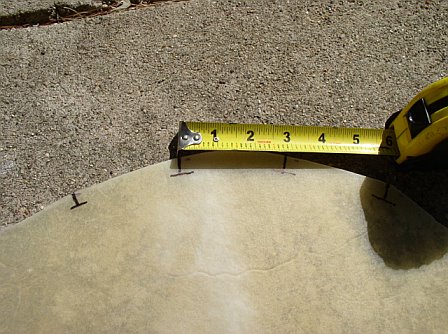
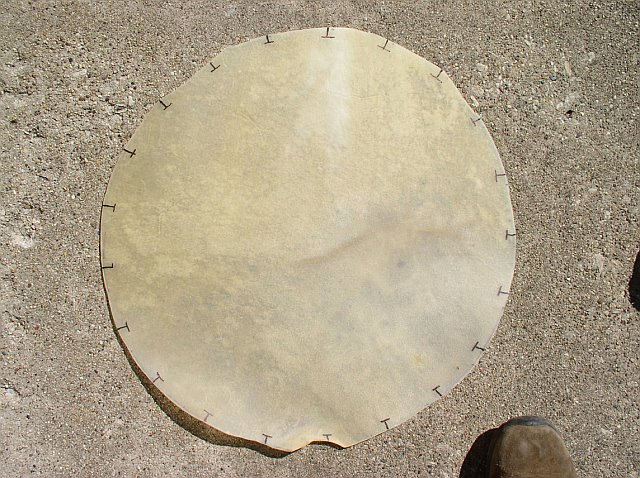 Note: It does need to be an ODD number of pulls so that you can tie the end of the pulling twine back to itself.
Note: It does need to be an ODD number of pulls so that you can tie the end of the pulling twine back to itself. Wipe the excess water off of the hide so you can make marks on it. Pencils, crayons and ball-point pens won’t make a mark on wet hide at all, so I use a felt-tip permanent marker. The outer edge will get trimmed off later. Look at both sides of the hide. One side is smoother than the other. The smooth side will be the outer side on the finished drum; the smooth side is the playing surface. Keep track of which side is which during the next few steps.
A note here on how I like to work: I make my calculations and my marks before I do any cutting for a very simple reason. I don’t want to handle too many tools or do too many separate operations at the same time; while I’m marking, I only want to handle my tape measure and my marker, then when I’m cutting, I only have to concentrate on my hammer and chisel. For this reason, I do only one step at a time. That keeps it simple and manageable for me.
With that in mind, after I mark the spacing of the slots I’m going to make, I mark another set of lines about 3/4 of an inch off the edge of the hide, so that the two marks—in a T shape—tell me exactly where to place my chisel each time. Using pieces of dowel to tension the hide onto the ring is my “innovation”. The articles I’ve seen about making shime heads have said to merely put the twine through the hide, but I find that most twine will rip the hide if I pull it very tight. One article even said to use fishing line to pull the hide tight onto the ring. Ouch! I do not recommend using fishing line for this job at all. I use ¼-inch twine made of a cotton/poly blend and it doesn’t hurt my fingers to pull on it. I don’t believe in hurting myself to make a drum.
Once I have all my marks, I use my hammer and wood chisel to cut a pair of slots at each place I’ve marked. For this particular head, I make these slots ½-inch long and ½-inch apart. The slot needs to be about twice as long as the diameter of the piece of dowel. Since I’m using ¼-inch dowel, I make ½-inch slots. For 3/8-inch dowels, I’d make ¾-inch slots.
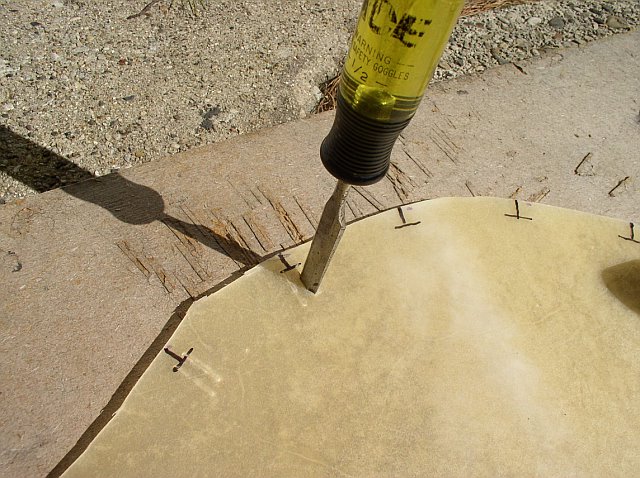 After all the slots are cut, I begin pushing the dowels through them. I start from the smooth side—with the hide back in the soak-tub so that the slots are nice and slippery. With the smooth side up, I push a dowel into one slot, then back out through the next slot ½-inch away. They should fit snug, so it will be kind of hard to push the dowels through the slots. The water helps; so does giving the dowel a little twist on the way through. Sometimes I put the hide against the edge of the tub to help me push. Just 21 of these dowels to push, then I can move on to the next step.
After all the slots are cut, I begin pushing the dowels through them. I start from the smooth side—with the hide back in the soak-tub so that the slots are nice and slippery. With the smooth side up, I push a dowel into one slot, then back out through the next slot ½-inch away. They should fit snug, so it will be kind of hard to push the dowels through the slots. The water helps; so does giving the dowel a little twist on the way through. Sometimes I put the hide against the edge of the tub to help me push. Just 21 of these dowels to push, then I can move on to the next step.  Once all the dowels are in and the hide is once again resting in the soak tub, the smooth side should look like this:
Once all the dowels are in and the hide is once again resting in the soak tub, the smooth side should look like this:  with the ENDS of the dowels protruding, while the rougher side should look like this:
with the ENDS of the dowels protruding, while the rougher side should look like this: 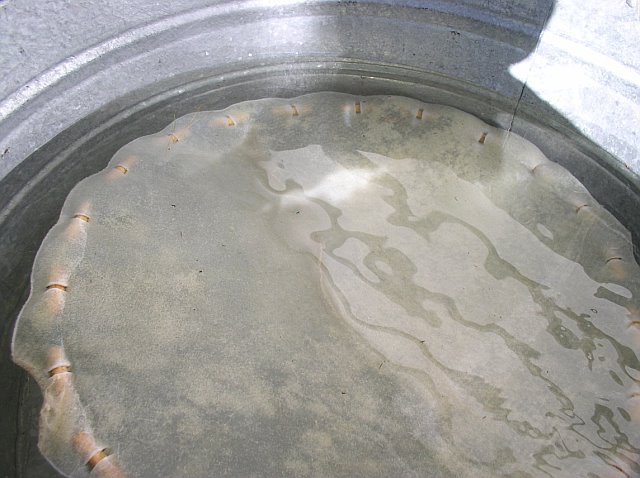 with the back side of the hide-loop and the middle of the dowel visible. To continue, click the link that says "next post-- making heads for shimedaiko part 2"
with the back side of the hide-loop and the middle of the dowel visible. To continue, click the link that says "next post-- making heads for shimedaiko part 2" Making Heads for Shimedaiko Part 2
At this point, I’d like for any drum-maker to notice that the instructions I’ve given so far could be applied to several different kinds of drum. I’m going to continue with shimedaiko directions, but you could easily make a different type of drum by using the same methods, but putting the hide on any sort of hoop— wood, plastic, metal, whatever, as long as it’s a STRONG hoop—then securing it to the hoop in an appropriate way. I’d like to make these directions useful to anyone who wants to use them, so I want you to notice the adaptability of the methods.
For simplicity’s sake, we’re going to refer to the piece of dowel through the slots in the hide as a mimi. That’s Japanese for “ear”. It’s easier to use one word for these pull-points you just made. Lacing the mimi to tighten the hide to the ring is going to sound more complicated than it really is, but I’m going to give some explicit instructions about how to do it because if you get it wrong, you’ll have to undo it and start over. Following the complex instructions makes the actual work simpler because you’ll get it right on the first try.
Tool-pile at the ready. Bring on the hide...
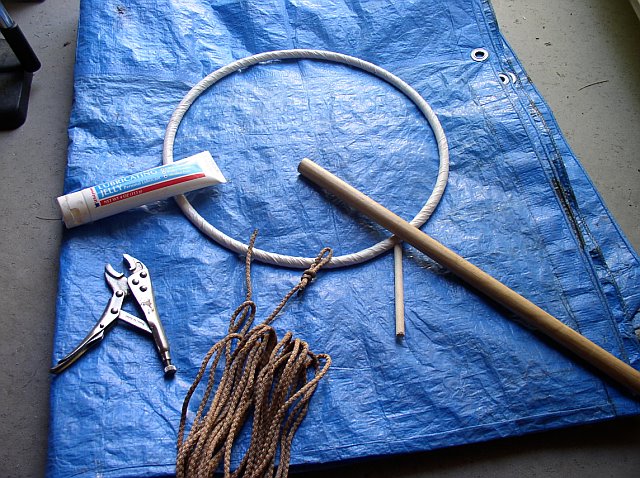 ...dripping wet.
...dripping wet. 
Lay the hide on your working surface with the smooth (outer) side down. Place the ring on top of it so that an even amount of hide shows all the way around the perimeter of the ring. You can coat the ring with your water-soluble lube first or just squeeze some on the ring, hide and all. It will wash out later.
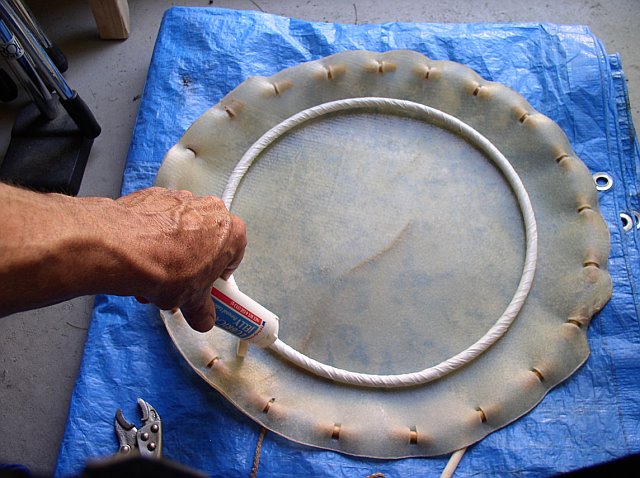
Take the section of the hide that is furthest away from you and fold it inwards over the ring. Call the first mimi that you grab “mimi number one”. (These directions are for a 21-pull head. Adjust as needed) Put the looped end of your pulling twine between the dowel and the hide to the left side of mimi 1 with the knot of the loop locked under the dowel, but the loop itself hanging free. Loop it clockwise (or start at the right and go counter-clockwise. All that matters is that you continue in the same direction once you start) around the mimi. Starting with the one you just looped (actually HALF a loop) count mimis clockwise until you get to number 12. Pull the twine (not tight yet!) to the right side of #12, loop it around clockwise to the left side, then go back toward the first one, but this time loop around #2. 
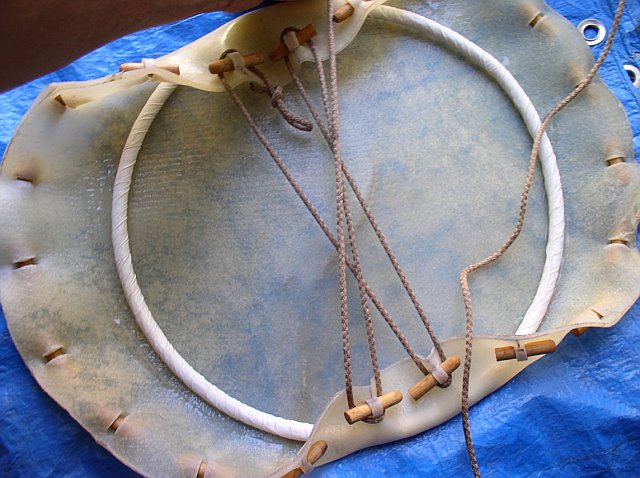 Keep going in a clockwise pattern until you have the twine around every mimi, crossing from one side of the drumhead to the other each time.
Keep going in a clockwise pattern until you have the twine around every mimi, crossing from one side of the drumhead to the other each time.
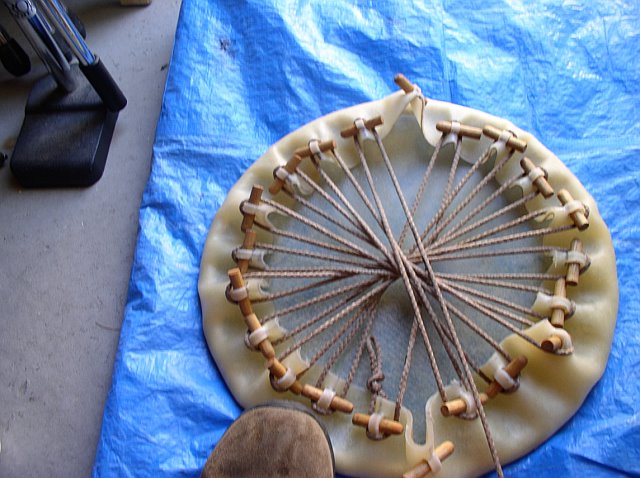
Here is the numeric sequence just to make sure you have it right, but really if you start right and you don’t skip any, it’s hard to do it wrong. Start at 1, then 12,2,13,3,14,4,15,5,16,6,17,7,18,8,19,9,20,10,21,11, then back to 1. Put the end of the twine through the loop you left at mimi number 1 and tie a temporary knot.
Numbering the mimis might make it sound over-complicated. All you’re actually doing is going from one side of the head to the other and back again, always in the same direction; in this instance—clockwise.
Now you can start pulling it tight, in the same pattern. I’ll tell you my method for pulling and hopefully it will make sense. I pull the slipknot right up against the first mimi, then go to number 12. I grasp the mimi with two fingers of one hand while I have the twine in the other hand. At the same time, I pull the mimi toward the center of the drumhead and the twine toward the outside, such that I am pulling my two hands away from one another, as if I was trying to pry an elevator door open. I keep the mimi that I’m currently pulling near the center of my body so that I’m pulling in both directions away from my center. I can get pretty good leverage this way. To clarify, the movement I’m talking about is just like this: make fists with your hands and hold them out in front of yourself with the backs of the knuckles touching. Then pull them apart—right hand to the right, left hand to the left. Now do the same with a looped piece of twine between them. Now do the same with the looped twine attached to a piece of hide. Congratulations! You’ve just learned to do something most people would be afraid to do! It really isn’t all that hard. Well, it isn’t the EASIEST thing in the world either, but…
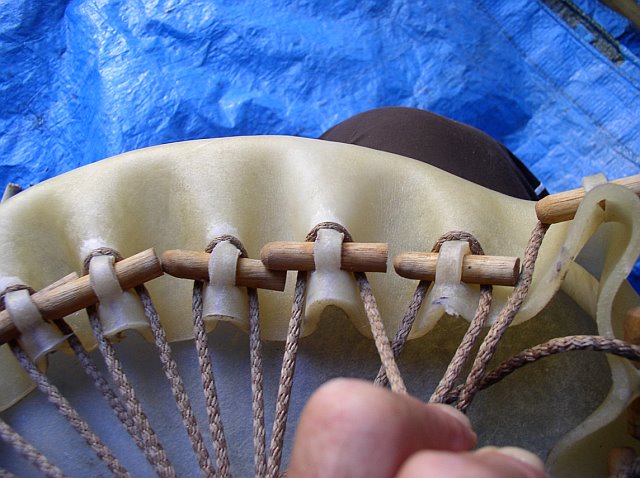

Once you have one section tight, you “lock it in” by wrapping it around the mimi. You’ll be keeping the tension on the twine with one hand throughout the process. You may have to work your way around the drumhead two or three times to get all the slack out, but with practice, you’ll be able to weave the twine in one pass, then tighten it in one more pass.
After you get all the way around—back to the loop at mimi number one—pull all the slack through the loop, make one last pull and tie a secure knot. Look at the folded edges of the hide. Most of the time, there will be an area that isn’t pulled in as much as the rest. Take some small pieces of dowel, put them between the two sections of twine that go to and from the mimi that needs to be pulled more and twist the twine together. Be careful not to scrape the hide much. I always round the ends of my twist sticks so I don’t inadvertently cut any hide—mine or the drum’s.
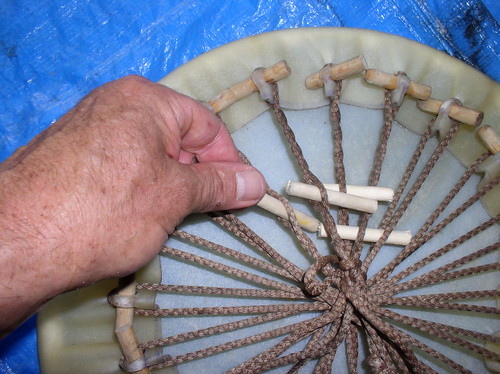
At this point, you can decide whether you’ve tightened the hide enough or not. It should feel fairly taut and it might even make a low tone if you tap it with your fingers (never hit a wet drumhead with a stick!) If it’s still too loose, you can twist more sticks into the twine, tap the mimis inward with a hammer and a small piece of dowel as a driver, grasp the edges and twist from playing-head-side to underside, pull on the twine more or any or all of the above. The wet hide will seem much looser than it will be after it dries (or you could say that after it dries, the finished drumhead will be much tighter than it was when it was wet) so at some point, call it good enough and slide the whole thing back into your soak tub, have a bit of tea or sake and get ready to stitch.
Making Heads for Shimedaiko Part 3
By now, we have a strong piece of thoroughly wet hide tighly stretched onto a steel ring. There are only three things left to do before we can call it a shime head: stitching it to the ring, trimming the excess hide off--the part that has the mimis--and cutting holes around the perimeter so it can be laced to a drum body.
This is my very first time making shime heads, although I've built other drums, including chudaiko, so I didn't get all the details right on the first try. Such is life. Hopefully we all survive a few mistakes and we learn something through our efforts.
The main challenges of stitching are that--to get a stitch through the hide, you have to make a hole in the hide to pass the needle through. After the stitching is done, you don't want to have a bunch of big holes where the stitches are. I made a couple of choices about stitching based on this basic compromise: I do the stitching while the hide is still wet and I use a punch to make the holes. If I used a drill, I would be removing little bits of hide where I drill. By using a punch, I make a hole without removing any material; the punch just pushes the hide to the sides. As it dries, a punched hole closes itself back around the stitch.
That led to another compromise situation. A punched hole in wet hide doesn't stay open for very long, so I punched, then stitched each stitch one by one. Punch, stitch, punch, stitch, repeat. I didn't count all the stitches, but it had to be a good 200 or so. The first head took over three hours to stitch this way. For the second one, I had it down to just over two hours.
A shime head needs one strong row of stitching close to the inside of the ring, but that row can't be TOO close to the ring or the front and back parts of the hide won't draw together. The width of the ring will keep them apart (no editorial comment here about wedding rings doing the same). The distance between the inside of the ring and the outer row of stitches should be approximately equal to the thickness of the ring i.e. since I'm using a ring made of 3/8-inch steel, I have to make my first row of stitches 3/8 of an inch away from the inside of the ring.
Two other factors come into play: this same area where the stitching is will also have the holes cut into it for the ropes to go through to tie the head to a body. The ropes need to be close to the edge without cutting through the stitching. The other factor is that this 14-inch head will go on a 10-inch drum body, so the distance between the outside of the ring and the outside of the body will be two inches all the way around (10-inch body+2 inches on all sides=a 14-inch overall diameter).

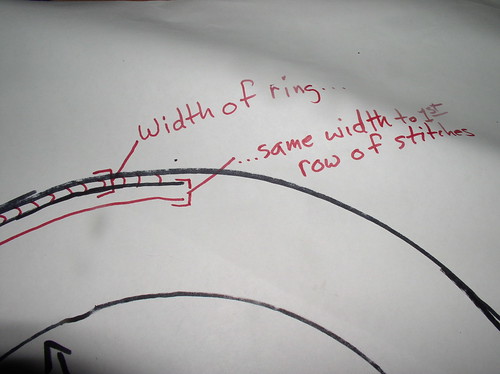
So...there's room for stitching and for a drum body with pull-ropes, but there is JUST ENOUGH room; neither too little nor too much.
I use artificial sinew for stitching because it's very strong for its size and it comes in big rolls so I can use a piece that's long enough to go all the way around without making any unnecessary extra knots. I punch the first hole, then a second one about 1/4-inch away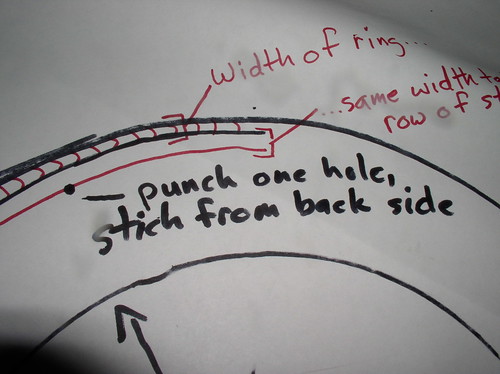
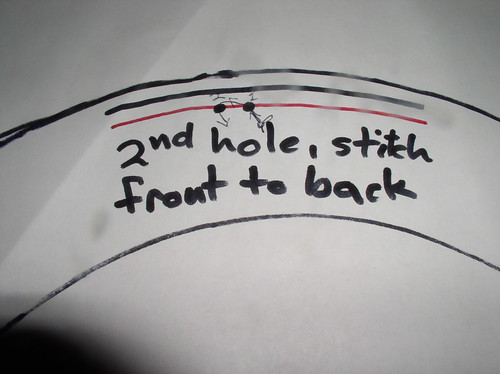
I cut a piece of sinew about 18 feet long because I know it will take about three times the circumference of the head by the time I double each stitch. I tie a slipknot it one end of the sinew and put a small piece of dowel into the loop of the slipknot so I can pull it tight to the hide without losing the knot. I make the first stitch from the back side of the head, then back through the second hole (front to back) then make another punch on the opposite side of the first stitch. After that, I punch/stitch in a continuous line so that from the back side, I skip a hole each time and loop each stitch back on itself from the front side.


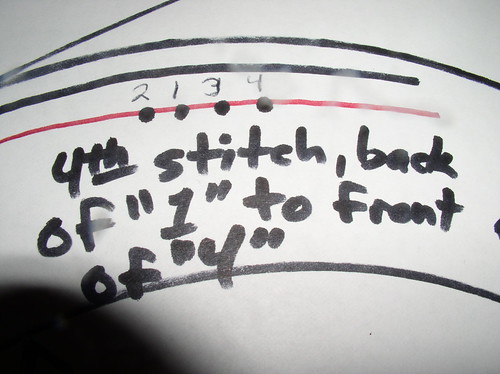
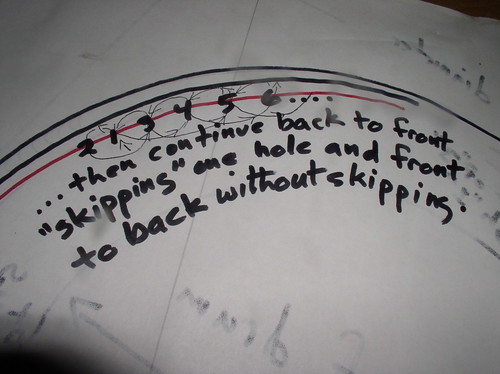
When I make my next shime head, I'm going to make a clamping ring/stitching guide to hold that outer edge together firmly while I stitch, but I haven't done that yet, so I can't say much about how it's going to work except that 1) it has to make the job easier and faster, not slower or harder and 2) it has to be something I can construct for myself because I'll want an exact size for it.
Anyway...stitching is the most time-consuming phase of making a shimedaiko head and also makes for the most boring photographs. I hope these diagrams will be useful. I'm basically just doing a loop stitch each time and putting all the knots on the underside of the head.
After stitching close to the ring, make another row of stitches--but these can be a simple in-and-out "weave" stitch--about 1-1/2 inches away from the outside of the ring. At that point, you can take all the pulling-twine and mimi-sticks out of the operation, then trim away the excess hide--just to the inside of the inner stitching--with surgical scissors. Other heavy-duty scissors will work, but surgical scissors are the best.
Then make ten evenly-spaced 1/2-inch diameter holes around the edge between the inner and outer rows of stitches. I used a punch that came with a grommet-kit for this part. Be careful not to cut through any of the stitches--the holes will be VERY CLOSE to the stitching. Keep those hands steady!
Let the whole thing dry for two or three days before doing anything else to it. Haven't you done enough already? Once it's completely dry, ream the punched holes with a 1/2-inch drill bit, again being careful not to cut the stitches.
After all that, you can tie the thing to a 10-inch shimedaiko body and hear its lovely, bright, happy voice; a voice YOU brought into being.
That's the fun part.
Enjoy!

